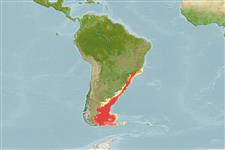Common names from other countries
Teleostei (teleosts) >
Gadiformes (Cods) >
Merlucciidae (Merluccid hakes)
Etymology: Merluccius: Latin, mar, maris = the sea + Latin, lucius = pike (Ref. 45335).
Environment: milieu / climate zone / depth range / distribution range
Ecology
Marine; benthopelagic; oceanodromous (Ref. 51243); depth range 50 - 800 m (Ref. 9715), usually 100 - 200 m (Ref. 1371). Temperate; 20°S - 56°S, 69°W - 40°W (Ref. 58452)
Southwest Atlantic: off southern Brazil to Argentina and the Falkland Islands up to 54°S (Ref. 47377).
Length at first maturity / Size / Weight / Age
Maturity: Lm 30.4 range ? - ? cm
Max length : 95.0 cm TL male/unsexed; (Ref. 1371); common length : 50.0 cm TL male/unsexed; (Ref. 1371); common length :60 cm TL (female); max. reported age: 6 years (Ref. 83871)
Dorsal spines (total): 1; Dorsal soft rays (total): 43 - 52; Anal spines: 0; Anal soft rays: 36 - 41; Vertebrae: 50 - 53. Gill rakers short and thick with blunt tips. Pectoral fins relatively short, not reaching level of anal fin origin. Color is silvery with golden luster on back, silvery white on belly (Ref. 1371).
Adults inhabit continental shelf depths mainly between 100 and 200 m (Ref. 1371). Larger individuals feed on fish (anchovies, hake, nototheniids, myctophids and Southern blue whitings), squids and macrozooplankton (euphausiids and amphipods); smaller individuals feed on mysids and amphipods (Ref. 1371). Migrate inshore during spring and summer, and offshore into deep water wintering areas after spawning; also undertake diel vertical migrations (Ref. 1371). Sold fresh and frozen.
An indeterminate batch spawner.
Cohen, D.M., T. Inada, T. Iwamoto and N. Scialabba, 1990. FAO species catalogue. Vol. 10. Gadiform fishes of the world (Order Gadiformes). An annotated and illustrated catalogue of cods, hakes, grenadiers and other gadiform fishes known to date. FAO Fish. Synop. 125(10). Rome: FAO. 442 p. (Ref. 1371)
IUCN Red List Status (Ref. 130435)
CITES (Ref. 128078)
Not Evaluated
Threat to humans
Harmless
Human uses
Fisheries: highly commercial
Tools
Warning: mysqli::__construct(): (08004/1040): Too many connections in /var/www/html/includes/speciessummary.lib.php on line 2104
Can't connect to MySQL database fbquizv2. Errorcode: Too many connections
